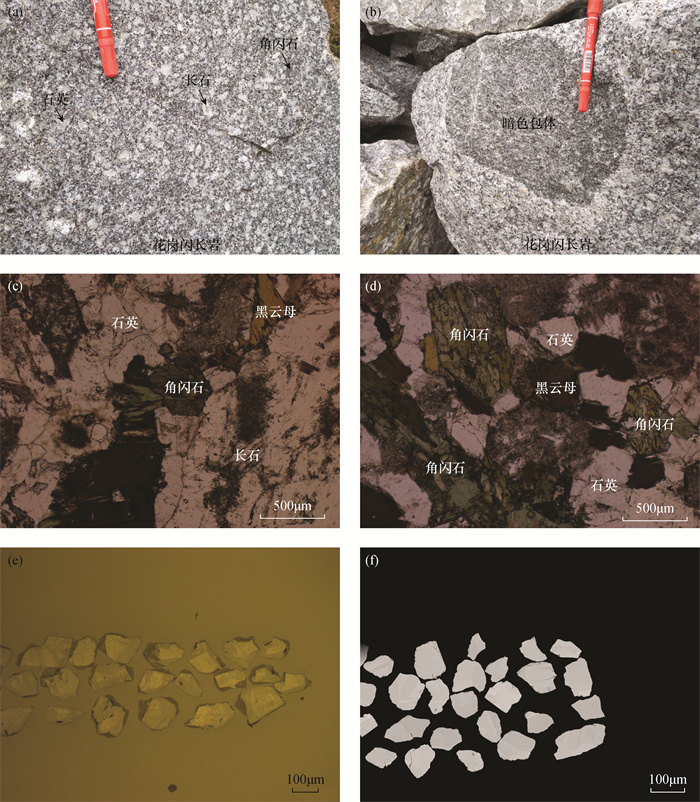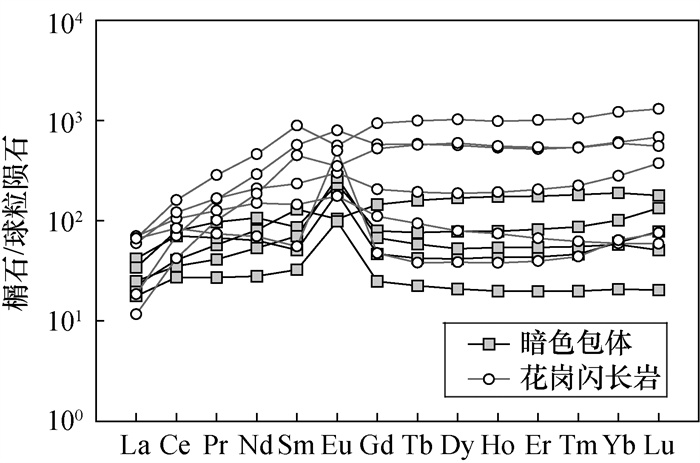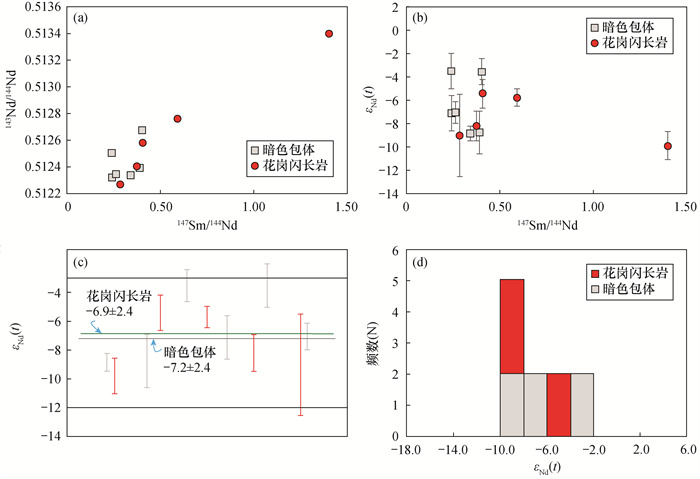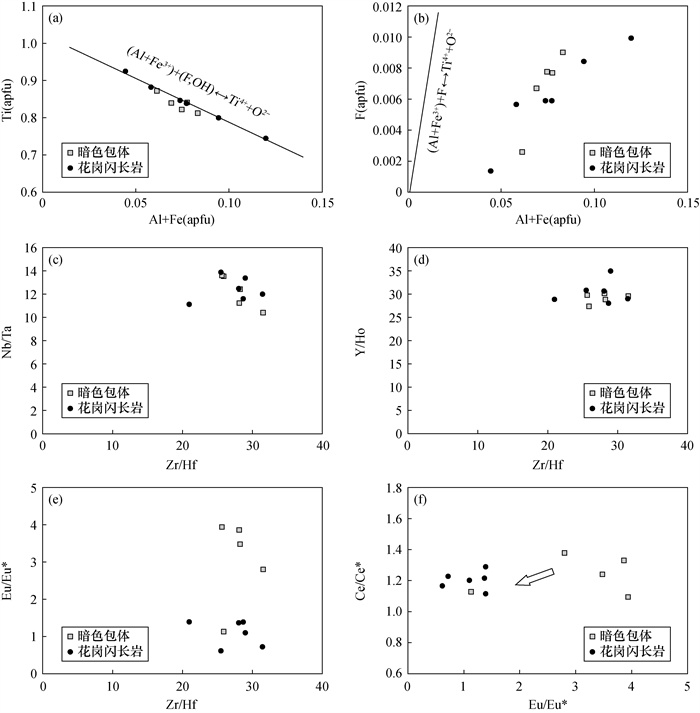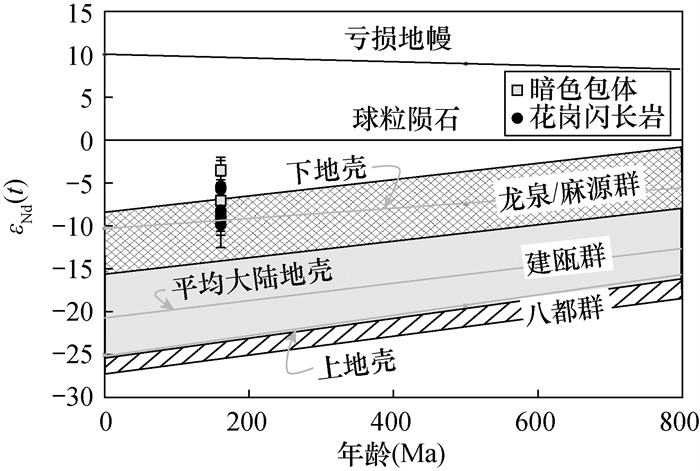Petrogenesis of the Mesozoic Tongshanling Granodiorite in Southern Hunan Province, South China: Clues from in-situ Nd Isotopes and Elements of the Titanite
-
摘要:
与热液矿床形成有关的花岗质岩石普遍遭受热液蚀变,且全岩成分仅代表均一化某一时间点的信息,采用全岩成分分析难以有效地揭示花岗质岩石的形成与演化。花岗质岩石中副矿物稳定不容易蚀变,近年原位测试技术的快速发展和日趋成熟,可以准确获取副矿物原位元素和同位素组成,通过副矿物元素和同位素组成可以有效地揭示岩浆来源和演化信息,显著提高了岩浆作用过程的空间分辨率,成为探讨岩石成因的新手段。本文以湘南与铜铅锌多金属成矿密切相关的铜山岭岩体为研究对象,利用电子探针(EPMA)、激光剥蚀等离子体质谱(LA-ICP-MS)和激光剥蚀多接收等离子体质谱(LA-MC-ICP-MS)等原位测试技术,对花岗闪长岩和暗色包体两类岩石样品中的副矿物榍石开展了原位元素和Nd同位素分析。结果表明:所有榍石中Al+Fe与Ti具有明显的负相关关系且稀土元素含量较高,稀土元素与Al和Fe一起主要通过(Al,Fe3+)+REE=Ti4++O2-方式替换榍石的Ti位和Ca位而进入晶格。球粒陨石标准化稀土配分模式上,大部分榍石显示Eu正异常。榍石中微量元素对Zr/Hf、Nb/Ta、Y/Ho比值变化范围分别为21.0~31.5、10.4~13.9、27.4~35.0,未发生明显分异。暗色包体中榍石的εNd(t)值为-3.5~-8.9,平均值为-7.2±2.4,花岗闪长岩中榍石的εNd(t)值为-5.4~-9.9,平均值为-6.9±2.4,所有榍石中Nd同位素组成均一且具有一致的负的初始Nd同位素组成,与华南大陆中下地壳Nd同位素演化趋势一致。元素地球化学特征表明,榍石中微量元素只与其晶体结构有关,不受热液蚀变作用的影响,能有效地示踪岩浆起源和性质。通过元素和同位素地球化学特征研究,本文认为铜山岭花岗质岩浆具有高温、高氧逸度特征,很可能由镁铁质角闪岩相中下地壳脱水熔融产生的水不饱和岩浆形成。
Abstract:BACKGROUND The compositions of the bulk-rocks are commonly modified by hydrothermal alteration or merely represent the magmatic information of snapshot during evolution. Hence, use of the chemical compositions of bulk-rocks makes it difficult to trace the source and evolution of granitic magmas. The petrogenesis of the granitic rock is therefore difficult to decipher. In the face of these difficulties, an alternative new approach is to trace the magmatic source and evolution by in-situ analyzing elements and isotope compositions of accessory minerals in granitic rocks. This new approach can significantly improve the spatial resolution of the magmatic processes. Titanite (CaTiSiO5) is a common accessory mineral of granitic rocks and contains a large amount of elements, including Al, Fe, Nb, Ta, Zr, Cr, V, Sn in the Ti site, and rare earth elements (REEs) Y, Na, Mn, Pb, U, Th, Sr and Ba in the Ca site. REEs and high field strength elements (HFSEs, i.e., Nb, Ta, Zr, Th and U) in titanite are sensitive to the changes of temperature, pressure, oxygen fugacity (fO2), water fugacity and melt composition. Additionally, titanite has high Nd concentration and low Sm/Nd ratio and is suitable for in-situ Nd isotope analyses. Therefore, titanite is an ideal accessory mineral to be used to investigate the magmatic source and evolution of granitic rocks.
OBJECTIVES To trace the magmatic source and evolution, and to decipher the petrogenesis of the granitic rock.
METHODS Titanite from mafic microgranular enclave (MME) and hosted granodiorite of the Tongshanling granitic pluton were checked by transmission light and back-scattered electron (BSE). BSE images were performed at the Institute of Geochemistry, Chinese Academy of Sciences (IGCAS) in Guiyang, on carbon-coated, polished epoxy blocks using JSM-7800F field emission scanning electron microscopy (SEM) operated at 20kV accelerating voltage and a beam current of 10nA. Their in-situ major element compositions were analysed by electron probe microanalyzer (EPMA) at IGCAS. An accelerating voltage of 25kV and a probe current of 10nA were applied. Well-characterized Kaersutite (Na, K, Mg, Al, Si, Ca, Mn, and Fe), apatite (F), and rutile (Ti) were used as standards. The trace elements of titanite were analysed in-situ by an Agilent 7900 ICPMS equipped with GeoLasPro 193nm ArF laser ablation system (LA-ICP-MS) at IGCAS. Analytical conditions were as follows: a fluence of 5J/cm2, at a repetition rate of 5Hz and laser spot of 44μm. Ca (determined by EPMA) was chosen as the internal standard and the reference glasses NIST610 and NIST612 were used to calibrate relative element sensitivities. In-situ Nd isotope of titanite were analyzed by a Nu Plasma Ⅲ multi-collector (MC) equipped with RESOlution-155 ArF 193nm laser ablation system (LA-MC-ICP-MS) at IGCAS. Titanite was ablated in a mixture of helium (350mL/min) and nitrogen (2mL/min) atmosphere using the following parameters: 30s baseline time, 40s ablation time, 72μm spot size, 6Hz repetition rate and 6J/cm2 energy density. The interference of 144Sm on 144Nd was derived from the 147Sm intensity with a natural 144Sm/147Sm ratio of 0.205484. The mass bias factor of Sm was calculated from the measured isotopic ratio of 144Sm/149Sm and its true value 1.08680. The mass bias of 143Nd/144Nd was normalized to 146Nd/144Nd=0.7129 with an exponential law. The reference materials MAD, Otter Lake, LAP and SAP were chosen as the external standards.
RESULTS Titanite grains in the MME, and host granodiorite of the Tongshanling granitic pluton have similar major element compositions. All titanite are characterized by high SiO2 (31.0% to 31.7%), CaO (29.0%-30.0%), TiO2 (30.6%-38.2%), and low Al2O3 (1.81%-5.61%), FeO (0.184%-0.606%), F (0.48%-1.84%) contents. The MnO concentrations vary between 0.024% and 0.066%. The MgO concentrations range from 0.001% to 0.031%. Compositional zoning among single titanite grains were not observed. The crystallo-chemical formulae were calculated on the basis of 5 oxygen atoms. The calculated results indicate that the Al+Fe (apfu) is negatively correlated with Ti (apfu) in all titanite grains. The analysed titanite grains have high rare earth element (REE) contents (67-1498μg/g). The REE were incorporated into titanite lattice by substituting for Ti and Ca site with Al and Fe and the substituted mechanism is (Al, Fe3+)+REE=Ti4++O2-. On the REE patterns, the titanite from granodiorite has REE contents higher than that from MME and shows weak positive or negative Eu anomaly (Eu/Eu* from 0.62 to 1.39). On the contrary, titanite from MME is characterized by Eu positive anomaly (Eu/Eu* from 1.13 to 3.94). These titanite contain high content of HFSEs such as Zr (11.1-536μg/g), Hf (0.639-21μg/g), Nb (306-1489μg/g) and Ta (24.7-109.5μg/g). The variation of Zr/Hf, Nb/Ta and Y/Ho ratios of titanite grains range from 21.0 to 31.5, 10.4 to 13.9 and 27.4 to 35.0, respectively. These trace element ratios are consistent with those of normal crust and are not fractionated. Therefore, the trace elements of titanite were completely controlled by ion radius and charge and not affected by late hydrothermal alteration. Titanite Zr thermometer shows that the temperature of titanite formation is between 762℃ and 963℃. Titanite from MME has homogenous Nd isotope compositions. Their present 144Nd/143Nd ranges from 0.512321 to 0.512675, corresponding to εNd(t) value from -3.5 to -8.9 with an average of -7.2±2.4 (N=6). Titanite from granodiorite overall have 144Nd/143Nd ratio ranging from 0.512269 to 0.513399. Their time-corrected initial εNd(t) value vary between -5.4 and -9.9 with an average of -6.9±2.4 (N=5). All titanite grains have negative initial Nd isotopic compositions, which is consistent with the evolution trend of Nd isotopes of the middle-lower continental crust of South China.
CONCLUSIONS Titanite grains in the MME and host granodiorite of the Tongshanling granitic pluton show little or no intra-grain concentric zoning in BSE images and display similar element and isotopic geochemical characteristics. Crystal chemical exerts a first-order control on elemental compositions of titanite. Titanite survived during hydrothermal alteration and faithfully recorded the information of granitic melts. The granitic melts of the Tongshanling are characterized by high temperature and oxygen fugacity. Granodiorites from the Tongshanling pluton were probably formed by the amphibole-dehydration melting of a mafic source in the middle-lower crust beneath South China.
-
Key words:
- LA-MC-ICP-MS /
- in-situ isotope analysis /
- Nd isotope /
- trace elements /
- titanite /
- granodiorite /
- southern Hunan Province
-

-
图 3 铜山岭榍石稀土元素配分模式图,暗色包体中榍石的稀土含量低于花岗闪长岩中榍石的稀土含量并具有明显的正Eu异常,而花岗闪长岩中的榍石显示出弱的正Eu或者负Eu异常。球粒陨石标准化数据据Sun和McDonough[31]
Figure 3.
表 1 铜山岭花岗闪长岩和暗色包体中榍石电子探针分析数据
Table 1. Representative EPMA data of titanite in granodiorite and mafic microgranular enclave of the Tongshanling pluton
元素/分析点 暗色包体(%) 花岗闪长岩(%) TSL4-1 TSL4-2 TSL4-3 TSL4-4 TSL4-5 TSL5-1 TSL5-2 TSL5-3 TSL5-4 TSL5-5 TSL5-6 Na2O 0.014 0.013 - 0.056 0.009 - - 0.003 - - - K2O 0.009 0.004 0.001 0.006 0.008 - - - - - - F 1.45 0.48 1.45 1.69 1.23 1.84 0.255 1.57 1.10 1.09 1.07 MgO - 0.003 0.001 - 0.005 0.031 0.001 0.017 - - 0.002 Al2O3 3.62 2.70 3.60 4.14 3.31 5.61 1.81 4.68 3.03 3.37 2.48 SiO2 31.7 31.4 31.2 31.3 30.7 31.3 31.1 31.4 31.6 31.0 31.6 Cl 0.017 - 0.008 0.012 0.002 0.005 - - 0.007 - 0.004 CaO 29.4 29.3 30.0 29.9 29.4 29.9 29.6 29.0 29.6 29.5 29.4 TiO2 33.9 35.7 35.1 33.7 34.0 30.6 38.2 32.9 35.0 34.2 36.8 MnO 0.059 0.043 0.024 0.045 0.061 0.028 0.044 0.053 0.066 0.024 0.027 FeO 0.220 0.356 0.366 0.190 0.184 0.465 0.378 0.191 0.606 0.456 0.432 总计 100 99.9 102 101 98.9 99.7 101 99.8 101 99.7 102 以O=5计算的阳离子个数(afpu) Na 0.001 0.001 - 0.003 0.001 - - - - - - Mg - - - - - 0.001 - 0.001 - - - Al 0.069 0.052 0.068 0.078 0.064 0.107 0.034 0.089 0.057 0.065 0.047 Si 1.021 1.020 0.996 1.004 1.008 1.013 1.001 1.015 1.016 1.010 1.007 Ca 1.013 1.020 1.026 1.025 1.032 1.038 1.020 1.002 1.020 1.030 1.006 Ti 0.822 0.872 0.841 0.812 0.840 0.745 0.925 0.800 0.847 0.839 0.883 Mn 0.002 0.001 0.001 0.001 0.002 0.001 0.001 0.001 0.002 0.001 0.001 Fe 0.006 0.010 0.010 0.005 0.005 0.013 0.010 0.005 0.016 0.012 0.012 F 0.008 0.003 0.008 0.009 0.007 0.010 0.001 0.008 0.006 0.006 0.006 F和Cl 0.001 - - 0.001 - - - - - - - Al+Fe 0.075 0.061 0.078 0.083 0.069 0.120 0.044 0.094 0.074 0.077 0.058 注:“-”代表低于检测限,下同。 表 2 铜山岭花岗闪长岩和暗色包体中榍石原位微量元素组成
Table 2. Trace element compositions of titanite in granodiorite and mafic microgranular enclave of the Tongshanling pluton
元素/分析点 暗色包体(μg/g) 花岗闪长岩(μg/g) TSL4-1 TSL4-2 TSL4-3 TSL4-4 TSL4-5 TSL5-1 TSL5-2 TSL5-3 TSL5-4 TSL5-5 TSL5-6 Li 0.431 0.565 0.141 0.264 0.050 1.17 - 0.082 0.260 0.942 - V 1461 571 610 1317 701 781 553 643 687 795 717 Ni 0.178 0.560 0.417 0.032 0.619 0.042 0.185 0.431 - 0.338 - Cu 0.532 0.510 0.589 0.329 0.761 0.648 0.596 0.265 0.357 0.347 0.651 Zn 2.22 2.36 3.49 1.91 2.59 1.76 1.02 2.94 1.15 2.21 1.31 Ga 8.27 6.41 6.58 7.61 6.31 3.56 3.88 7.71 7.68 2.23 6.38 As 0.776 2.36 0.632 0.365 2.66 7.54 1.51 2.63 3.80 3.25 0.796 Rb 0.063 0.742 0.088 - 0.003 0.242 0.051 0.033 0.137 0.087 0.099 Sr 4.66 6.61 6.16 4.74 6.29 7.23 7.51 6.22 7.62 11.3 6.42 Y 270 74.0 131 32.4 90.9 118 872 333 1706 74.9 906 Zr 16.5 143 26.8 59.4 486 11.1 154 190 536 474 67.0 Nb 384 584 354 306 1489 650 625 1069 1455 1217 963 Sn 861 4116 3960 1353 6594 90 1162 3503 1233 829 651 Cs 0.112 0.320 0.038 0.039 0.004 0.317 0.002 0.005 0.044 0.110 0.011 Ba 0.093 0.342 0.055 0.108 0.053 1.323 - 0.080 0.033 1.263 0.048 La 5.33 9.87 8.07 4.19 5.92 16.5 4.37 14.1 15.8 15.7 2.75 Ce 24.8 43.1 48.4 16.6 21.5 63.9 43.2 73.9 98.1 51.4 25.7 Pr 5.45 6.39 9.19 2.58 3.91 11.9 15.5 15.8 27.0 7.02 9.56 Nd 37.6 29.6 49.9 13.1 24.9 69.8 135.2 97.8 214 32.6 86.8 Sm 19.8 7.79 13.2 4.95 10.7 22.2 86.8 35.8 135 26.4 68.5 Eu 8.94 10.9 13.4 5.71 15.7 10.2 46.0 17.4 32.5 28.8 20.3 Gd 29.7 9.59 16.2 5.09 13.8 22.6 118 42.2 192 25.9 108 Tb 5.95 1.58 2.85 0.84 2.18 3.50 21.7 7.20 37.03 1.42 21.3 Dy 42.7 10.5 19.8 5.3 13.3 20.1 143 47.5 259 9.8 151 Ho 9.84 2.45 4.44 1.12 3.05 4.20 30.2 10.9 55.4 2.14 31.2 Er 29.0 7.2 13.5 3.3 9.0 11.0 85.5 33.9 166.4 6.5 89.3 Tm 4.63 1.18 2.21 0.51 1.40 1.58 13.73 5.69 26.6 1.12 13.6 Yb 32.1 10.3 17.2 3.5 9.8 10.1 103 47.5 206 10.8 100 Lu 4.52 1.97 3.38 0.52 1.29 1.49 17.3 9.48 33.0 1.91 14.1 Hf 0.639 5.09 0.849 2.10 19.0 0.387 7.36 6.77 21.0 16.4 2.13 Ta 28.4 52.1 34.0 24.7 109.5 56.0 56.2 85.7 104.8 91.0 80.3 W 10.2 167 50.5 13.3 173 11.1 3.24 609 366 144 6.15 Pb 0.495 1.386 0.502 0.280 1.14 5.52 0.540 1.43 1.39 1.68 0.427 Th 2.13 3.76 1.44 6.40 2.52 2.35 5.04 63.5 62.0 6.92 2.41 U 17.2 52.8 16.9 18.2 19.8 4.39 18.0 262 205 45.4 10.1 ΣREE 258 152 222 67 136 269 864 459 1498 187 742 LaN/YbN 0.12 0.69 0.34 0.85 0.43 1.17 0.03 0.21 0.06 1.04 0.02 T(℃) 762 878 786 828 956 743 883 895 963 954 834 Eu/Eu* 1.13 3.86 2.80 3.48 3.94 1.39 1.39 1.37 0.62 1.10 0.72 Ce/Ce* 1.13 1.33 1.38 1.24 1.09 1.12 1.29 1.22 1.17 1.20 1.23 Zr/Hf 25.9 28.1 31.5 28.3 25.6 28.7 21.0 28.0 25.5 29.0 31.4 Nb/Ta 13.5 11.2 10.4 12.4 13.6 11.6 11.1 12.5 13.9 13.4 12.0 Y/Ho 27.4 30.2 29.6 28.8 29.8 28.0 28.9 30.7 30.8 35.0 29.0 表 3 榍石原位Sm-Nd同位素组成
Table 3. In-situ Sm-Nd isotope compositions in titanite from granodiorite and mafic microgranular enclave of the Tongshanling pluton
暗色包体分析点 147Sm/144Nd 2σ 143Nd/144Nd 2σ εNd(t) 2σ fSm/Nd 2σ T4TNd07 0.3415 0.0099 0.512337 0.000442 -8.9 0.6 0.736 0.050 T4TNd09 0.3894 0.0010 0.512392 0.000095 -8.8 1.9 0.980 0.005 T4TNd10 0.4026 0.0026 0.512675 0.000057 -3.5 1.1 1.047 0.013 T4TNd11 0.2416 0.0048 0.512321 0.000283 -7.1 1.5 0.228 0.024 T4TNd12 0.2399 0.0072 0.512504 0.000744 -3.5 1.5 0.220 0.037 T4TNd13 0.2626 0.0018 0.512346 0.000509 -7.0 0.9 0.335 0.009 花岗闪长岩分析点 147Sm/144Nd 2σ 143Nd/144Nd 2σ εNd(t) 2σ fSm/Nd 2σ T3TNd01 1.4020 0.0098 0.513399 0.000267 -9.9 1.2 6.127 0.050 T5TNd01 0.4059 0.0026 0.512580 0.000166 -5.4 1.2 1.063 0.013 T5TNd02 0.5917 0.0046 0.512761 0.000140 -5.7 0.7 2.008 0.023 T5TNd05 0.3743 0.0047 0.512404 0.000270 -8.2 1.3 0.903 0.024 T3TNd03 0.2850 0.0048 0.512269 0.000693 -9.0 3.5 0.449 0.024 -
[1] Anne-Sophie M J, Pichavant M. Magmatic fraction-ation and the magmatic-hydrothermal transition in rare metal granites: Evidence from Argemela (central Portugal)[J]. Geochimica et Cosmochimica Acta, 2020, 289(15): 130-157.
[2] Lehmann B. Formation of tin ore deposits: A reassessment[J]. Lithos, 2020, 402-403(15): 105756.
[3] Sun W D, Zhang C C, Liang H Y, et al. The genetic association between magnetite-hematite and porphyry copper deposits: Reply to Pokrovski[J]. Geochimica et Cosmochimica Acta, 2014, 126: 639-642. doi: 10.1016/j.gca.2013.07.038
[4] Lackey J S, Valley J W, Hinke H J. Deciphering the source and contamination history of peraluminous magmas using δ18O of accessory minerals: Examples from garnet-bearing plutons of the Sierra Nevada batholith[J]. Contributions to Mineralogy and Petrology, 2006, 151(1): 20-44. doi: 10.1007/s00410-005-0043-6
[5] 吴福元, 李献华, 杨进辉, 等. 花岗岩成因研究的若干问题[J]. 岩石学报, 2007, 23(6): 1217-1238. doi: 10.3969/j.issn.1000-0569.2007.06.001
Wu F Y, Li X H, Yang J H, et al. Discussions on the petrogenesis of granites[J]. Acta Petrologica Sinica, 2007, 23(6): 1217-1238. doi: 10.3969/j.issn.1000-0569.2007.06.001
[6] Li X H, Li W X, Wang X C, et al. Role of mantle-derived magma in genesis of early Yanshanian granites in the Nanling Range, South China: In situ zircon Hf-O isotopic constraints[J]. Science in China: Series D—Earth Sciences, 2009, 52(9): 1262-1278. doi: 10.1007/s11430-009-0117-9
[7] Waight T E, Tørnqvist J B. Sr isotope zoning in plagio-clase from andesites at Cabo De Gata, Spain: Evidence for shallow and deep contamination[J]. Lithos, 2018, 308-309: 159-167. doi: 10.1016/j.lithos.2018.03.007
[8] Grimes C, Wooden J, Cheadle M, et al. "Fingerprinting" tectono-magmatic provenance using trace elements in igneous zircon[J]. Contributions to Mineralogy and Petrology, 2015, 170(5-6): 1-26.
[9] Miles A J, Graham C M, Hawkesworth C J, et al. Apatite: A new redox proxy for silicic magmas?[J]. Geochimica et Cosmochimica Acta, 2014, 132: 101-119. doi: 10.1016/j.gca.2014.01.040
[10] Emo R B, Smit M A, Schmitt M, et al. Evidence for evolved Hadean crust from Sr isotopes in apatite within Eoarchean zircon from the Acasta gneiss complex[J]. Geochimica et Cosmochimica Acta, 2018, 235: 450-462. doi: 10.1016/j.gca.2018.05.028
[11] Fisher C M, Bauer A M, Luo Y, et al. Laser ablation split-stream analysis of the Sm-Nd and U-Pb isotope compositions of monazite, titanite, and apatite—Improvements, potential reference materials, and application to the Archean Saglek Block gneisses[J]. Chemical Geology, 2020, 539: 119493. doi: 10.1016/j.chemgeo.2020.119493
[12] McLeod G W, Dempster T J, Faithfull J W. Deciphering magma-mixing processes using zoned titanite from the ross of mull granite, Scotland[J]. Journal of Petrology, 2011, 52(1): 55-82. doi: 10.1093/petrology/egq071
[13] Bruand E, Storey C, Fowler M, et al. Oxygen isotopes in titanite and apatite, and their potential for crustal evolution research[J]. Geochimica et Cosmochimica Acta, 2019, 255: 144-162. doi: 10.1016/j.gca.2019.04.002
[14] Zhao Z, Wang C Y, Wei B, et al. Elemental and Nd isotopic compositions of zoned titanite in mafic microgranular enclaves of the early Cretaceous Sanguliu granitic pluton in the North China Craton: Insights into magma mixing process[J]. Lithos, 2021, 392-393: 106138. doi: 10.1016/j.lithos.2021.106138
[15] Hammerli J, Kemp A I S, Spandler C. Neodymium isotope equilibration during crustal metamorphism revealed by in situ microanalysis of REE-rich accessory minerals[J]. Earth & Planetary Science Letters, 2014, 392: 133-142.
[16] Laurent O, Zeh A, Gerdes, A et al. How do granitoid magmas mix with each other? Insights from textures, trace element and Sr-Nd isotopic composition of apatite and titanite from the Matok pluton (South Africa)[J]. Contributions to Mineralogy and Petrology, 2017, 172(9): 80. doi: 10.1007/s00410-017-1398-1
[17] Yang Y H, Wu F Y, Yang J H, et al. Sr and Nd isotopic compositions of apatite reference materials used in U-Th-Pb geochronology[J]. Chemical Geology, 2014, 385: 35-55. doi: 10.1016/j.chemgeo.2014.07.012
[18] Huang X, Lu J, Sizaret S, et al. Petrogenetic differences between the middle-late Jurassic Cu-Pb-Zn-bearing and W-bearing granites in the Nanling Range, South China: A case study of the Tongshanling and Weijia deposits in southern Hunan Province[J]. Science China: Earth Sciences, 2017, 60(7): 1220-1236. doi: 10.1007/s11430-016-9044-5
[19] Yang J H, Kang L F, Peng J T, et al. In-situ elemental and isotopic compositions of apatite and zircon from the Shuikoushan and Xihuashan granitic plutons: Implication for Jurassic granitoid-related Cu-Pb-Zn and W mineralization in the Nanling Range, South China[J]. Ore Geology Reviews, 2018, 93: 382-403. doi: 10.1016/j.oregeorev.2017.12.023
[20] Huang J C, Peng J T, Yang J H, et al. Precise zircon U-Pb and molybdenite Re-Os dating of the Shuikoushan granodiorite-related Pb-Zn mineralization, southern Hunan, South China[J]. Ore Geology Reviews, 2015, 71: 305-317. doi: 10.1016/j.oregeorev.2015.06.011
[21] Zhao P, Yuan S, Mao J, et al. Zircon U-Pb and Hf-O isotopes trace the architecture of polymetallic deposits: A case study of the Jurassic ore-forming porphyries in the Qin—Hang metallogenic belt, China[J]. Lithos, 2017, 292: 132-145.
[22] Huang X D, Lu J J, Sizaret S, et al. Reworked restite enclave: Petrographic and mineralogical constraints from the Tongshanling intrusion, Nanling Range, South China[J]. Journal of Asian Earth Sciences, 2018, 166: 1-18. doi: 10.1016/j.jseaes.2018.07.001
[23] 王岳军, 范蔚茗, 郭锋, 等. 湘东南中生代花岗闪长质小岩体的岩石地球化学特征[J]. 岩石学报, 2001, 17(1): 169-175. https://www.cnki.com.cn/Article/CJFDTOTAL-YSXB200101017.htm
Wang Y J, Fan W M, Guo F, et al. Petrological and geochemical characteristics of Mesozoic granodioritic intrusions in southeast Hunan Province, China[J]. Acta Petrologica Sinica, 2001, 17(1): 169-175. https://www.cnki.com.cn/Article/CJFDTOTAL-YSXB200101017.htm
[24] Wang Y, Fan W, Guo F. Geochemistry of early Mesozoic potassium-rich diorites-granodiorites in southeastern Hunan Province, South China: Petrogenesis and tectonic implications[J]. Geochemical Journal, 2003, 37(4): 427-448. doi: 10.2343/geochemj.37.427
[25] 卢友月, 付建明, 程顺波, 等. 湘南铜山岭铜多金属矿田成岩成矿作用年代学研究[J]. 大地构造与成矿学, 2015, 39(6): 1061-1071. doi: 10.16539/j.ddgzyckx.2015.06.008
Lu Y Y, Fu J M, Cheng S B, et al. Rock-forming and ore-forming ages of Tongshanling copper polymetallic ore-field in southern Hunan Province[J]. Geotectonica et Metallogenia, 2015, 39(6): 1061-1071. doi: 10.16539/j.ddgzyckx.2015.06.008
[26] 王岳军, 范蔚茗, 郭锋, 等. 湘东南中生代花岗闪长岩锆石U-Pb法定年及其成因指示[J]. 中国科学: D辑, 2001, 31(9): 745-751. https://www.cnki.com.cn/Article/CJFDTOTAL-JDXK200109005.htm
Wang Y J, Fan W M, Guo F, et al. Zircon U-Pb dating of the Mesozoic granitoids from southeastern Hunan Province[J]. Science in China (Series D), 2001, 31(9): 745-751. https://www.cnki.com.cn/Article/CJFDTOTAL-JDXK200109005.htm
[27] 蔡应雄, 谭娟娟, 杨红梅, 等. 湘南铜山岭铜多金属矿床成矿物质来源的S, Pb, C同位素约束[J]. 地质学报, 2015, 89(10): 1792-1803. doi: 10.3969/j.issn.0001-5717.2015.10.007
Cai Y X, Tan J J, Yang H M, et al. The origin of ore-forming material in the Tongshanling Cu-polymetallic ore field in Hunan Province: Constrains from S-Pb-C isotopes[J]. Acta Geologica Sinica, 2015, 89(10): 1792-1803. doi: 10.3969/j.issn.0001-5717.2015.10.007
[28] 袁顺达. 湘南铜山岭矿田玉龙矽卡岩型钼矿床辉钼矿Re-Os测年[J]. 地质论评, 2013, 59(Z1): 393-394. https://cpfd.cnki.com.cn/Article/CPFDTOTAL-DXHD201304001173.htm
Yuan S D. Molybdenite Re-Os dating of the Yulong skarn-type Mo deposit from Tongshanling ore-filed in South Hunan Province[J]. Geological Revies, 2013, 59(Z1): 393-394. https://cpfd.cnki.com.cn/Article/CPFDTOTAL-DXHD201304001173.htm
[29] Dubois J, Retali G, Cesario J. Isotopic analysis of rare earth elements by total vaporization of samples in thermal ionization mass spectrometry[J]. International Journal of Mass Spectrometry and Ion Processes, 1992, 120(3): 163-177. doi: 10.1016/0168-1176(92)85046-3
[30] Yang Y, Sun J, Xie L, et al. In situ Nd isotopic measurement of natural geological materials by LA-MC-ICPMS[J]. Chinese Science Bulletin, 2008, 53(7): 1062-1070.
[31] Sun S S, McDonough W F. Chemical and isotopic syste-matics of oceanic basalts: Implications for mantle composition and processes[J]. Geological Society of London (Special Publications), 1989, 42(1): 313-345. doi: 10.1144/GSL.SP.1989.042.01.19
[32] Perseil E A, Smith D C. Sb-rich titanite in the manganese concentrations at St. Marcel-Praborna, Aosta Valley, Italy: Petrography and crystal-chemistry[J]. Mineralogical Magazine, 1995, 59(397): 717-734. doi: 10.1180/minmag.1995.059.397.13
[33] Cao M, Qin K, Li G, et al. In situ LA-(MC)-ICP-MS trace element and Nd isotopic compositions and genesis of polygenetic titanite from the Baogutu reduced porphyry Cu deposit, western Junggar, NW China[J]. Ore Geology Reviews, 2015, 65(4): 940-954.
[34] Xu L, Bi X, Hu R, et al. LA-ICP-MS mineral chemistry of titanite and the geological implications for exploration of porphyry Cu deposits in the Jinshajiang—Red River alkaline igneous belt, SW China[J]. Mineralogy and Petrology, 2015, 109(2): 181-200. doi: 10.1007/s00710-014-0359-x
[35] 马倩, 杨岳衡, 赵志丹, 等. 云南哀牢山—红河剪切带新生代富碱侵入岩中榍石年代学和地球化学特征[J]. 岩石学报, 2020, 36(9): 2751-2778. https://www.cnki.com.cn/Article/CJFDTOTAL-YSXB202009010.htm
Ma Q, Yang Y H, Zhao Z D, et al. Titanite geochronology and geochemistry of the Cenozoic alkali-rich intrusions in the Ailaoshan—Red River shear zone, Yunnan Province[J]. Acta Petrologica Sinica, 2020, 36(9): 2751-2778. https://www.cnki.com.cn/Article/CJFDTOTAL-YSXB202009010.htm
[36] Gao X Y, Zheng Y F, Chen Y X, et al. Geochemical and U-Pb age constraints on the occurrence of polygenetic titanites in UHP metagranite in the Dabie orogen[J]. Lithos, 2012, 136-139: 93-108. doi: 10.1016/j.lithos.2011.03.020
[37] Storey C D, Jeffries T E, Smith M. Common lead-corrected laser ablation ICP-MS U-Pb systematics and geochronology of titanite[J]. Chemical Geology, 2006, 227(1-2): 37-52. doi: 10.1016/j.chemgeo.2005.09.003
[38] Ballouard C, Poujol M, Boulvais P, et al. Nb-Ta fraction-ation in peraluminous granites: A marker of the magmatic-hydrothermal transition[J]. Geology, 2016, 44(3): 231-234. doi: 10.1130/G37475.1
[39] Bau M. Controls on the fractionation of isovalent trace elements in magmatic and aqueous systems: Evidence from Y/Ho, Zr/Hf, and lanthanide tetrad effect[J]. Contributions to Mineralogy and Petrology, 1996, 123(3): 323-333. doi: 10.1007/s004100050159
[40] Breiter K, Škoda R. Zircon and whole-rock Zr/Hf ratios as markers of the evolution of granitic magmas: Examples from the Teplice caldera (Czech Republic/Germany)[J]. Mineralogy and Petrology, 2017, 111(4): 435-457. doi: 10.1007/s00710-017-0509-z
[41] Irber W. The lanthanide tetrad effect and its correlation with K/Rb, Eu/Eu*, Sr/Eu, Y/Ho, and Zr/Hf of evolving peraluminous granite suites[J]. Geochimica et Cosmochimica Acta, 1999, 63(3-4): 489-508. doi: 10.1016/S0016-7037(99)00027-7
[42] Hayden L A, Watson E B, Wark D A. A thermobarometer for sphene (titanite)[J]. Contributions to Mineralogy and Petrology, 2008, 155(4): 529-540. doi: 10.1007/s00410-007-0256-y
[43] Seifert W, Kramer W. Accessory titanite: An important carrier of zirconium in lamprophyres[J]. Lithos, 2003, 71(1): 81-98. doi: 10.1016/j.lithos.2003.07.002
[44] 朱乔乔, 谢桂青, 蒋宗胜, 等. 湖北金山店大型矽卡岩型铁矿热液榍石特征和原位微区LA-ICPMS U-Pb定年[J]. 岩石学报, 2014, 30(5): 1322-1338. https://www.cnki.com.cn/Article/CJFDTOTAL-YSXB201405010.htm
Zhu Q Q, Xie G Q, Jiang Z S, et al. Characteristics and in situ U-Pb dating of hydrothermal titanite by LA-ICPMS of the Jingshandian iron skarn deposit, Hubei Province[J]. Acta Petrologica Sinica, 2014, 30(5): 1322-1338. https://www.cnki.com.cn/Article/CJFDTOTAL-YSXB201405010.htm
[45] Chappell B W, White A J R, Williams I S, et al. Low- and high-temperature granites[J]. Earth & Environ-mental Science Transactions of the Royal Society of Edinburgh, 2004, 95(1-2): 125-140.
[46] King P L, Sham T K, Gordon R A, et al. Microbeam X-ray analysis of Ce3+/Ce4+ in Ti-rich minerals: A case study with titanite (sphene) with implications for multivalent trace element substitution in minerals[J]. American Mineralogist, 2013, 98(1): 110-119. doi: 10.2138/am.2013.3959
[47] Jiang Y H, Jiang S Y, Dai B Z, et al. Middle to late Jurassic felsic and mafic magmatism in southern Hunan Province, southeast China: Implications for a continental arc to rifting[J]. Lithos, 2009, 107(3-4): 185-204. doi: 10.1016/j.lithos.2008.10.006
[48] 孔华, 金振民. 道县玄武岩中麻粒岩包体的岩石学及年代学[J]. 长春科技大学学报, 2000, 30(2): 115-119. https://www.cnki.com.cn/Article/CJFDTOTAL-CCDZ200002002.htm
Kong H, Jin Z M. Petrology and chronology of granulite xenolith in Daoxian County, Hunan Province[J]. Journal of Changchun University of Science and Technology, 2000, 30(2): 115-119. https://www.cnki.com.cn/Article/CJFDTOTAL-CCDZ200002002.htm
[49] Yu J H, Xu X, O'Reilly S Y, et al. Granulite xenoliths from Cenozoic basalts in SE China provide geochemical fingerprints to distinguish lower crust terranes from the North and South China tectonic blocks[J]. Lithos, 2003, 67(1-2): 77-102. doi: 10.1016/S0024-4937(02)00253-0
[50] 袁忠信, 吴良士, 张宗清, 等. 闽北麻源群Sm-Nd、Rb-Sr同位素年龄研究[J]. 岩石矿物学杂志, 1991, 10(2): 127-132. https://www.cnki.com.cn/Article/CJFDTOTAL-YSKW199102003.htm
Yuan Z X, Wu L S, Zhang Z Q, et al. The Sm-Nd, Rb-Sr isotopic age-dating of Mayuan Group in northern Fujian[J]. Acta Petrologica et Mineralogica, 1991, 10(2): 127-132. https://www.cnki.com.cn/Article/CJFDTOTAL-YSKW199102003.htm
[51] Chen J, Jahn B M. Crustal evolution of southeastern China: Nd and Sr isotopic evidence[J]. Tectonophysics, 1998, 284(1): 101-133.
[52] Beard J, Lofgren G. Dehydration melting and water-saturated melting of Basaltic and Andesitic greenstones and amphibolites at 1, 3, and 6.9kb[J]. Journal of Petrology, 1991, 32(2): 365-401. doi: 10.1093/petrology/32.2.365
[53] Wolf M, Wyllie P. Dehydration-melting of amphibolite at 10kbar: the effects of temperature and time[J]. Contributions to Mineralogy and Petrology, 1994, 115(4): 369-383.
-



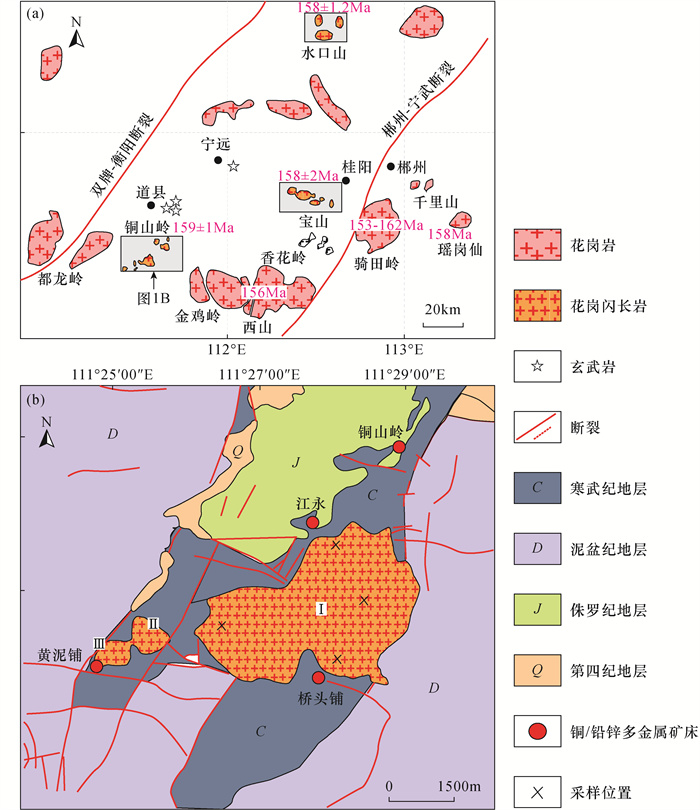
 下载:
下载:
